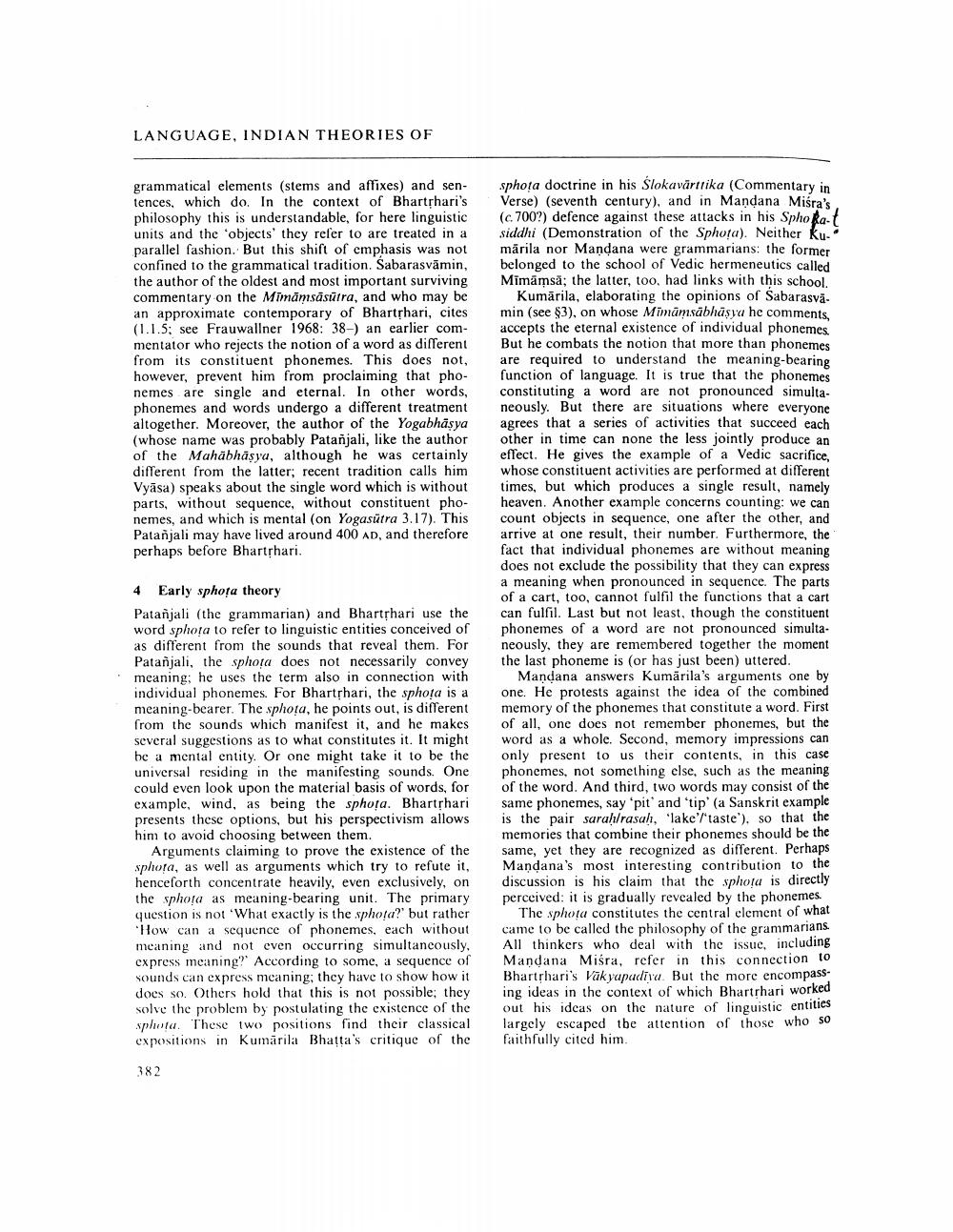Book Title: Language Indian Theories Of Author(s): Johannes Bronkhorst Publisher: Johannes Bronkhorst View full book textPage 4
________________ LANGUAGE, INDIAN THEORIES OF grammatical elements (stems and affixes) and sentences, which do. In the context of Bharthari's philosophy this is understandable, for here linguistic units and the objects' they refer to are treated in a parallel fashion. But this shift of emphasis was not confined to the grammatical tradition. Sabarasvāmin, the author of the oldest and most important surviving commentary on the Mimām.sāsūtra, and who may be an approximate contemporary of Bhartshari, cites (1.1.5: see Frauwallner 1968: 38-) an earlier commentator who rejects the notion of a word as different from its constituent phonemes. This does not, however, prevent him from proclaiming that phonemes are single and eternal. In other words, phonemes and words undergo a different treatment altogether. Moreover, the author of the Yogabhasya (whose name was probably Patanjali, like the author of the Mahābhāsya, although he was certainly different from the latter; recent tradition calls him Vyāsa) speaks about the single word which is without parts, without sequence, without constituent phonemes, and which is mental (on Yogasutra 3.17). This Patanjali may have lived around 400 AD, and therefore perhaps before Bharthari. 4 Early sphota theory Patanjali (the grammarian) and Bharthari use the word sphora to refer to linguistic entities conceived of as different from the sounds that reveal them. For Patanjali, the sphoța does not necessarily convey meaning; he uses the term also in connection with individual phonemes. For Bhartshari, the sphota is a meaning-bearer. The sphota, he points out, is different from the sounds which manifest it, and he makes several suggestions as to what constitutes it. It might be a mental entity. Or one might take it to be the universal residing in the manifesting sounds. One could even look upon the material basis of words, for example, wind, as being the sphota. Bhartshari presents these options, but his perspectivism allows him to avoid choosing between them. Arguments claiming to prove the existence of the sphora, as well as arguments which try to refute it, henceforth concentrate heavily, even exclusively, on the sphora as meaning-bearing unit. The primary question is not "What exactly is the sphota?' but rather How can a sequence of phonemes, each without meaning and not even occurring simultaneously, express meaning?' According to some, a sequence of sounds can express meaning; they have to show how it does so. Others hold that this is not possible; they solve the problem by postulating the existence of the spheta. These two positions find their classical expositions in Kumārila Bhatta's critique of the sphota doctrine in his Slokavärtrika (Commentary in Verse) (seventh century), and in Mandana Miśra's (c.700?) defence against these attacks in his SphoRat siddhi (Demonstration of the Sphota). Neither ku. marila nor Mandana were grammarians: the former belonged to the school of Vedic hermeneutics called Mimāmsā; the latter, too, had links with this school. Kumārila, elaborating the opinions of Sabarasva. min (see $3), on whose Mimāmsábhaswa he comments. accepts the eternal existence of individual phonemes But he combats the notion that more than phonemes are required to understand the meaning-bearing function of language. It is true that the phonemes constituting a word are not pronounced simultaneously. But there are situations where everyone agrees that a series of activities that succeed each other in time can none the less jointly produce an effect. He gives the example of a Vedic sacrifice, whose constituent activities are performed at different times, but which produces a single result, namely heaven. Another example concerns counting: we can count objects in sequence, one after the other, and arrive at one result, their number. Furthermore, the fact that individual phonemes are without meaning does not exclude the possibility that they can express a meaning when pronounced in sequence. The parts of a cart, too, cannot fulfil the functions that a cart can fulfil. Last but not least, though the constituent phonemes of a word are not pronounced simulta. neously, they are remembered together the moment the last phoneme is (or has just been) uttered. Mandana answers Kumärila's arguments one by one. He protests against the idea of the combined memory of the phonemes that constitute a word. First of all, one does not remember phonemes, but the word as a whole. Second, memory impressions can only present to us their contents, in this case phonemes, not something else, such as the meaning of the word. And third, two words may consist of the same phonemes, say 'pit' and 'tip' (a Sanskrit example is the pair sarah/rasah, 'lakertaste). so that the memories that combine their phonemes should be the same, yet they are recognized as different. Perhaps Mandana's most interesting contribution to the discussion is his claim that the sphota is directly perceived: it is gradually revealed by the phonemes. The sphota constitutes the central element of what came to be called the philosophy of the grammarians. All thinkers who deal with the issue, including Mandana Miśra, refer in this connection to Bharthari's Vak yapadīva. But the more encompass. ing ideas in the context of which Bhartrhari worked out his ideas on the nature of linguistic entities largely escaped the attention of those who so faithfully cited him. 382Page Navigation
1 2 3 4 5 6
